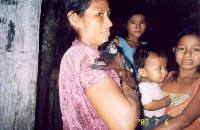Click images to enlarge
After the serious medical work, an excursion had been planned
for the group to one of the several camps/lodges which exist
along the river and in the surrounding jungle. We joined this
group as we wanted to see what is known as the canopy walk bridges.
There are a few in other places. I am told there is one in Australia,
another one in Costa Rica and apparently one being built somewhere
in Africa. Well, this one is still the longest one with roughly
800 metres of bridge walks between the tops of huge trees. We
started off at a lodge by the name of Ceiba Tops, a very sanforized place
with cabins with air conditioning, hot water and fans. A big
"maloca" (hut with palm leaf roof) served as restaurant,
bar, meeting place and administration building and had mosquito
netting all around it. To my great surprise, and although everybody
was well armed with all sorts of repellents, few if any insects
bothered us. This could be because outings were during the hours
when all these buggers had already done their stuff, which is
early morning and late afternoon.
off at a lodge by the name of Ceiba Tops, a very sanforized place
with cabins with air conditioning, hot water and fans. A big
"maloca" (hut with palm leaf roof) served as restaurant,
bar, meeting place and administration building and had mosquito
netting all around it. To my great surprise, and although everybody
was well armed with all sorts of repellents, few if any insects
bothered us. This could be because outings were during the hours
when all these buggers had already done their stuff, which is
early morning and late afternoon.
Other than the hundreds of parrots of all sizes and colors
which fly continuously everywhere, little bird life was seen
except when going to specific areas where no civilization has
installed itself and then only very early in the morning. Even
on our walks in the forest itself, other than a monkey here and
there, a few exotic insects and butterflies, no big game wanted
anything to do with  humans
ogling around. The tapir in the picture at the left is a big
and beautiful fellow raised from infancy by the camp people and,
having been castrated, is tame and docile and ready to be photographed
by all. Guillermo was offered a boa constrictor of over 5 metres,
sort of in secrecy, by an Indian who quickly disappeared when
one of the guides appeared. Peru is very strict in conservancy
and plant and animal collecting are strictly forbidden.
humans
ogling around. The tapir in the picture at the left is a big
and beautiful fellow raised from infancy by the camp people and,
having been castrated, is tame and docile and ready to be photographed
by all. Guillermo was offered a boa constrictor of over 5 metres,
sort of in secrecy, by an Indian who quickly disappeared when
one of the guides appeared. Peru is very strict in conservancy
and plant and animal collecting are strictly forbidden.
 |
 |
 |
|
|
||
Well, the Ceiba Lodge organization has several others in the
forest which are simpler and more interesting if nature is the
goal. They have plain cooking, camp beds with mosquito nets,
gas lamps and latrines. Since all these lodges are reached via
boats and canoes and jungle walking, it is a haven for botanists,
biologists, linguists and missionaries who are all doing their
work in the immensity of the jungle. From one of the camps we proceeded
to the canopy setup and, let me tell you, it is a feat of engineering
and beauty. Well and safely built, protecting the trees from
which the various cables and bridges hang, it is an experience
to walk on top of the trees and seeing nothing but lush green
and blue sky. Of course the abundance of plants (orchids, bromeliads
and other epiphytes) is tremendous. Having just ended the real
rainy season, little was in bloom, but it was still an awesome
sight. Even those suffering from vertigo felt safe and eager
to take more steps on those moving bridges in the air.
we proceeded
to the canopy setup and, let me tell you, it is a feat of engineering
and beauty. Well and safely built, protecting the trees from
which the various cables and bridges hang, it is an experience
to walk on top of the trees and seeing nothing but lush green
and blue sky. Of course the abundance of plants (orchids, bromeliads
and other epiphytes) is tremendous. Having just ended the real
rainy season, little was in bloom, but it was still an awesome
sight. Even those suffering from vertigo felt safe and eager
to take more steps on those moving bridges in the air.
